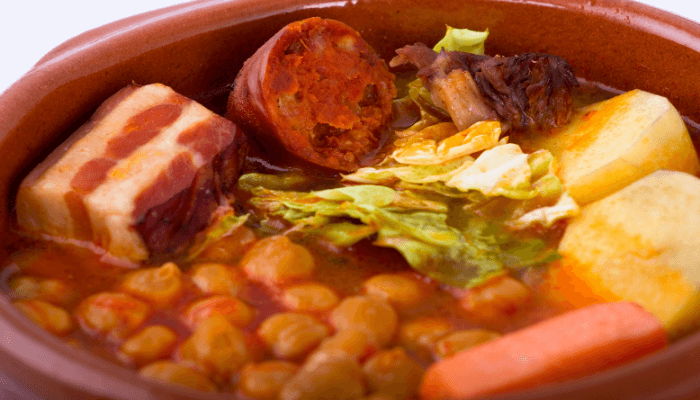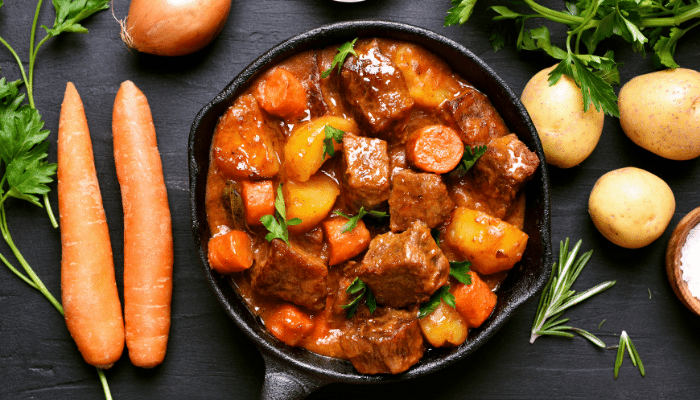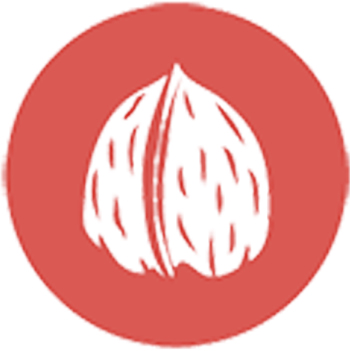
- Ingredients
- Procedure
- Allergens
Recipe of the best traditional Madrid stew
The Madrid stew is one of the most representative recipes of the cuisine of the Spanish capital . Its origin comes from the lower classes since it was prepared with leftovers from the entire week and a little water, preparing a broth with bones, vegetables and if lucky, a little sausage.
Little by little this dish became popular in the city of Madrid and restaurants began to include it in their menus and letters. This made the Madrid stew stop being a typical dish for the poor and become a typical dish of Spanish gastronomy .
I remember the first time I tried this dish. It was during a course I did during my master's degree. I spent 3 weeks in Madrid. One day I had free I went downtown with a friend and we saw a restaurant that offered a menu that included Madrid cooked first course.
We ate there. It was winter and the broth from the stew came to me very good to warm up . I liked it so much that the next day we ate again at the same restaurant.
When I arrived in my city, in Barcelona, I decided to try preparing the Madrid broth on my own. The first time it was a bit bland, but the second time I added more sausage and meat and it was really delicious.
The recipe for Madrid stew soup that I bring today is a mixture of many recipes that I have tried for this dish. Finally I have given it my personal touch since that is personally how I like it the most.
After the step-by-step explanation, I leave a section of keys to improve the cooking even more. If you like hot foods you can't miss our dish of canarian lentils either the traditional Andalusian lentil stew .
Don't you have any ingredients? Here are other similar recipes
Stew ingredients
How to make Madrid stew
- The night before we soak the chickpeas with water and a little salt so that the next day, when we prepare the broth, the chickpeas are soft. Before starting to prepare the Madrid stew, we drain the chickpeas and store them.
- We take a large pot (preferably a pressure cooker), add water (approximately 2 liters) and add the bones, meat and zucchini with skin. We will cook the blood sausages and chorizos separately to prevent our broth from filling with fat.
- We also add the chickpeas to the pot. We recommend adding them with a mesh to facilitate their later removal.
- We take a separate casserole where we will cook the blood sausage and chorizos. We add water, prick the chorizos and blood sausages and cook them for 15-20 minutes. We then reserve for later use.
- We cover the pot and put it over high heat until it starts to boil. Once the water is boiling we can lower the heat a little.
- While the stew is cooking, peel the potatoes and carrots. We reserve them whole, without cutting.
- When approximately an hour has passed, we open the pressure cooker and add the carrots and potatoes. We close and let it cook for about 10 minutes.
- While the stew broth is cooking, take a saucepan with water and cook the cabbage. We let it cook for about 20-30 minutes. We can add the cabbage with the rest or leave it separately.
- Finally we open the package of noodles and add them to the pot with the rest of the ingredients. We let it cook for the time indicated on the noodle package.
- Once the noodles are cooked, prick the potato to check that it is done. If so, we can now serve the Madrid stew on 4 plates. There are people who prefer to separate the meat, vegetables and chickpeas from the broth. If so, we remove the mesh from the chickpeas and strain the meat and vegetable broth.
Tricks to cook the best stew
There are some tricks to improve the Madrid stew recipe. I like to make the broth the day before eating it and leave it in the refrigerator overnight. In this way we will ensure that the fat remains on the surface and we will be able to defat the broth by removing the foam with a slotted spoon.
To be able to remove the chickpeas from the broth we can use racks or meshes. This way we can cook them and remove them once they are cooked to serve them in a dish separate from the broth.
It is important to prepare the blood sausages and chorizos in a separate casserole or saucepan to avoid excess fat in our Madrid stew.
If you want to use ham bone, I recommend leaving it in water for a few hours to clean it and eliminate the possible rancid taste that it can give our broth.
If there is leftover food we can use the meat and bones to prepare delicious croquettes or exquisite meat cannelloni. With chickpeas we can prepare a typical Arab dish, hummus.


















